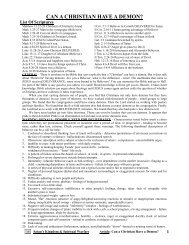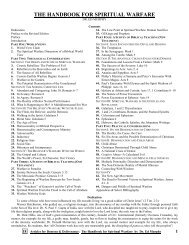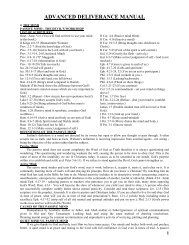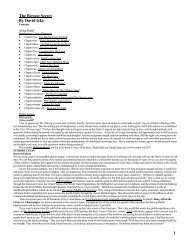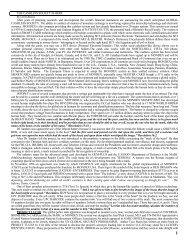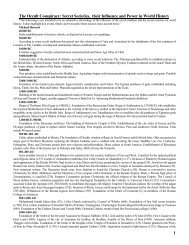Gilgal Rephaim Table of Contents {A} Did Biblical ... - Bread of Life
Gilgal Rephaim Table of Contents {A} Did Biblical ... - Bread of Life
Gilgal Rephaim Table of Contents {A} Did Biblical ... - Bread of Life
Create successful ePaper yourself
Turn your PDF publications into a flip-book with our unique Google optimized e-Paper software.
<strong>Gilgal</strong> <strong>Rephaim</strong><br />
<strong>Table</strong> <strong>of</strong> <strong>Contents</strong><br />
{A} <strong>Did</strong> <strong>Biblical</strong> Giants Build the Circle <strong>of</strong> the Refaim?<br />
{B} <strong>Gilgal</strong><br />
{C} Giants<br />
{D} <strong>Rephaim</strong><br />
{A} DID BIBLICAL GIANTS BUILD THE CIRCLE<br />
OF THE REFAIM?<br />
Article by Israeli Journalist/Author, Barry Chamish<br />
(chamish@netmedia.net.il) 12/97<br />
[please note: some definitions and comments have been<br />
added and are indicated by {..}]<br />
One <strong>of</strong> the last great barely known wonders <strong>of</strong> the ancient<br />
world is a Stonehenge-like monument sitting atop Israel's Golan<br />
Heights. Called <strong>Gilgal</strong> Refaim (The Circle Of The Refaim) in<br />
Hebrew, the monument consists <strong>of</strong> five concentric stone rings<br />
whose diameter is 155 meters.<br />
The best preserved <strong>of</strong> the rings is the outermost, whose<br />
height reaches 2 meters and thickness 3.3 meters. Some <strong>of</strong> the<br />
stones used to create the ring weigh twenty tons. The total weight<br />
<strong>of</strong> the stones is 37,000 tons.<br />
Circle <strong>of</strong> the Refaim<br />
Graphic provided by Barry Chamish<br />
In the middle <strong>of</strong> the rings is a cairn 1, topped by a tumulus 2,<br />
measuring twenty meters across.<br />
{1} cairn - a heap <strong>of</strong> stones set up as a landmark, monument,<br />
tombstone, etc. {2} tumulus - a domelike swelling or mound<br />
formed in congealed lava; a barrow (Webster's Dictionary)<br />
Despite the obvious attraction to archaeologists, the rings<br />
remained hidden while the suspicious Syrian regimes held the<br />
Golan Heights and were only opened to inspection after Israel<br />
won the area in the Six Day War <strong>of</strong> 1967.<br />
One feature <strong>of</strong> the rings has particularly fascinated the few<br />
people who have studied them. It is the meaning <strong>of</strong> two large<br />
openings, somewhat like doorways, one facing northeast, the<br />
other southeast.<br />
In 1968 Pr<strong>of</strong>essor Yonathan Mizrahi <strong>of</strong> the Department <strong>of</strong><br />
Anthropology at Harvard University and Pr<strong>of</strong>. Anthony Aveni <strong>of</strong><br />
Colgate University discovered that in 3000 BCE, the first rays <strong>of</strong><br />
the summer solstice would have appeared directly through the<br />
northeast opening as seen from the central tumulus. At the same<br />
time, the southeast opening provided a direct view <strong>of</strong> Sirius.<br />
One function <strong>of</strong> the circles then, was an astronomical<br />
observatory and stellar calendar. Or was it?<br />
Pr<strong>of</strong>. Mizrahi is doubtful. "Why would they have undertaken<br />
such a massive building project, collecting 37,000 tons <strong>of</strong> stone<br />
and painstakingly laying them down to last forever, when<br />
the same task could have been completed using one rock<br />
and a stick?"<br />
In fact, no one knows why the site was built -- thus<br />
speculation is rife. Micah Ankouri, for instance, writing in<br />
Teva Ve'aretz (Land and Nature) spends five pages trying<br />
to provide a connection between the circles and Far Eastern<br />
mandalas. He concludes that <strong>Gilgal</strong> Refaim was an<br />
"astronomical observatory providing social harmony<br />
through its communal construction and pro<strong>of</strong> <strong>of</strong> the<br />
perfection <strong>of</strong> the universe."<br />
The astronomical dating confirms lichenometric tests<br />
and carbon dating <strong>of</strong> potsherds found on the site. In fact,<br />
the pr<strong>of</strong>essors erred on the side <strong>of</strong> conservatism. The<br />
sherds dated to the Early Bronze Age, 3rd millenium BCE,<br />
5000 years ago. A three layered burial monument was<br />
added to the central cairn a thousand years later. Thus, the<br />
circles pre-date the pyramids and Babylonian temples,<br />
making them the oldest astronomical complex in the<br />
Middle East.<br />
The mysteries continue. <strong>Gilgal</strong> Refaim is the only<br />
megalithic astronomical complex on earth built <strong>of</strong> loose<br />
stones. It resembles more ruins found on Malta and in<br />
Zimbabwe than European sites<br />
built at the same time and possibly for the same purpose.<br />
But despite the similarity <strong>of</strong> purpose, supposedly the<br />
simple nomads <strong>of</strong> the region had no contact with Europe.<br />
Nor were the shepherd tribes prone to massive building<br />
projects. <strong>Gilgal</strong> Refaim<br />
was the only such undertaking in the Middle East at the<br />
time. There was no apparent cultural reason for this unique<br />
engineering project.<br />
For those seeking a possible UFO connection: the<br />
circles were built on a flat plateau. No one could have seen<br />
the shape <strong>of</strong> the monument from ground level and there<br />
were no hills nearby to gaze upon it. Yet the monument<br />
could only have been appreciated from above. It was as<br />
likely a message to the stars as a stellar observatory.<br />
In the general region <strong>of</strong> the rings are hundreds <strong>of</strong><br />
dolmens 3 , similar in appearance to those found in<br />
northern Britain and France. Moshe Hartal, Chief<br />
Archaeologist <strong>of</strong> the Golan explains, "We have identified<br />
8,500 dolmens <strong>of</strong> twenty separate styles on the Golan<br />
Heights. Each tribe had its own dolmen style. The biggest<br />
dolmen stones weigh over 50 tons and are seven metres in<br />
height. Graves are found within some domens but not all.<br />
Their function was not purely funereal."<br />
{{3} dolmen - a structure usually regarded as a tomb,<br />
consisting <strong>of</strong> two or more large, upright stones set with a<br />
space between and capped by a horizontal stone.<br />
(Webster's Dictionary)<br />
The Palestinian dolmens "are usually very simple: one<br />
or more horizontal blocks were laid over a few vertical<br />
ones averaging a meter (39 in) or less in height, with a low<br />
entrance on one side. These may have been monuments to<br />
the dead, designed as imitations <strong>of</strong> everyday<br />
1
dwellings...Originally, they were probably covered with small<br />
stones and earth, which has been washed away. Occasionally, one<br />
or two circles <strong>of</strong> small stones surrounded them. Nearly always<br />
they are clustered in 'fields' or groups, mostly in northwestern<br />
Jordan on the slopes above the east bank <strong>of</strong> the Jordan River, or<br />
in upper Galilee..." (Nelson's Illustrated Encyclopedia <strong>of</strong> Bible<br />
Facts; page 75). }<br />
If the dolmens surrounding <strong>Gilgal</strong> Refaim were an integral<br />
part <strong>of</strong> the site, then it was an enormous project encompassing<br />
more area than at the Giza pyramids. Hartel is reluctant to draw<br />
such a<br />
conclusion, taking the more conservative view that the dolmens<br />
were built over time around the attraction <strong>of</strong> the circles.<br />
One fact stands out. The local nomadic tribes <strong>of</strong> the time did<br />
not build any other remotely similar monument. Circle building<br />
was not a fashion <strong>of</strong> the era among the herdsmen and that,<br />
combined with their unsuitable, primitive technology, seems to<br />
rule out their construction <strong>of</strong> the circles.<br />
If the local inhabitants didn't build the rings, then who did?<br />
Surpisingly, there is strong evidence that the biblical giants or<br />
Refaim were the architects and engineers who constructed the<br />
monument.<br />
Consider the following biblical clues, written in modern<br />
terminology (The Book, Tyndale House Publishers):<br />
In Genesis 14:5, we are told the Refaim inhabit the<br />
place called Ashtherot-Karnaim. Just ten miles from the<br />
rings is the site <strong>of</strong> an ancient Canaanite city called<br />
Ashtherot. It is named after the Canaanite goddess <strong>of</strong><br />
war and, contradictorily, love. Ashterot was the<br />
Canaanite name for Sirius, from which the Hebrew name<br />
Esther was derived.<br />
In Joshua 12:4, we learn that "King Og <strong>of</strong> Bashan,<br />
the last <strong>of</strong> the Refaim, who lived at Ashtarot... ruled a<br />
territory stretching From Mount Hermon in the north...<br />
In 1 Chronicles 6:71, we are told that the half-tribe<br />
<strong>of</strong> Manasseh later inhabited "Golan," in Bashan.<br />
The most explicit description <strong>of</strong> the size <strong>of</strong> the<br />
people <strong>of</strong> Bashan is found in Deuteronomy 3. King Og is<br />
attacked and defeated. "King Og <strong>of</strong> Bashan was the last<br />
<strong>of</strong> the great Refaim. His iron bedstead is kept at<br />
Rabbah... and measures thirteen and a half feet long and<br />
six feet wide." In the same chapter we are informed that<br />
"The Sidonians called Mount Hermon, 'Sirion.'"<br />
In Deuteronomy, we are told that the Refaim "were<br />
a large and powerful tribe, as tall as the Anakim<br />
(giants)."<br />
In Chronicles 20, the last <strong>of</strong> the Anakim is killed. "A<br />
giant with six fingers on each hand and six toes on each<br />
foot, whose father was also a giant,... was killed by<br />
David's nephew Jonathan. These giants were<br />
descendants <strong>of</strong> the giants <strong>of</strong> Gath and were killed by<br />
David and his soldiers."<br />
The respected Jerusalem biblical author, Rabbi Yisrael<br />
Herczeg, hardly an advocate <strong>of</strong> ancient alien theories, nonethless<br />
confirms the possibility that giant heavenly beings or their<br />
descendants could have constructed the circles.<br />
"The Jewish oral tradition says Og, the King <strong>of</strong> Bashan,<br />
stowed away on Noah's ark and was the only survivor <strong>of</strong> the flood<br />
outside Noah's family. Og was descended from the<br />
Nefilim, deities who fell from the heavens."<br />
Aliens?<br />
"No, more like fallen angels. Og had children with<br />
Noah's daughters and they were hybrid giants called the<br />
Anakim or Refaim. They existed in ancient times and the<br />
Bible records their presence in the Golan Heights. They<br />
could have built <strong>Gilgal</strong> Refaim."<br />
Written by Barry Chamish<br />
{B} <strong>Gilgal</strong><br />
(Josh 4:19-20 KJV) "And the people came up out <strong>of</strong><br />
Jordan on the tenth day <strong>of</strong> the first month, and encamped in<br />
<strong>Gilgal</strong>, in the east border <strong>of</strong> Jericho. {20} And those twelve<br />
stones, which they took out <strong>of</strong> Jordan, did Joshua pitch in<br />
<strong>Gilgal</strong>."<br />
Commentary to above verse from - The Bible<br />
Knowledge Commentary, Old Testament:<br />
"Joshua led the people to <strong>Gilgal</strong>, their first<br />
encampment in Canaan, about two miles from Jericho.<br />
There the 12 stones... taken out <strong>of</strong> the Jordan were set up,<br />
perhaps in a small circle. The name <strong>Gilgal</strong> means "circle,"<br />
and may have been taken from an ancient circle <strong>of</strong> stones<br />
<strong>of</strong> pagan significance. If so, the more recent circle<br />
commemorating Yahweh's great work would serve to<br />
counteract the idolatrous association <strong>of</strong> the site."<br />
{C} Giants<br />
(Gen 6:4 KJV) "There were giants in the earth in those<br />
days; and also after that, when the sons <strong>of</strong> God came in<br />
unto the daughters <strong>of</strong> men, and they bare children to them,<br />
the same became mighty men which were <strong>of</strong> old, men <strong>of</strong><br />
renown."<br />
1. The word "giants" in this verse has been translated<br />
from the Hebrew word 'nephiyl' or 'Nephilim' [Strong's<br />
5303]. "It means a bully, a tyrant, a giant. It appears three<br />
times in the O.T. There was much controversy concerning<br />
these individuals. Since the etymology is uncertain, there is<br />
much speculation among reputable scholars. The<br />
translation 'giants' in the KJV came from the Septuagint<br />
and may be misleading. Does Gen 6:4 refer to the fall <strong>of</strong><br />
angels? Were they apostates? It is possible that the word<br />
means 'heroes' or 'fierce warriors.' Until more evidence<br />
becomes available, perhaps it is wise to do as the RSV and<br />
NIV translations did, to render it "Nephilim."<br />
(The Hebrew-Greek Key Study Bible)<br />
2. "The form <strong>of</strong> the Hebrew word [Nephilim] denotes<br />
a plural verbal adjective or noun <strong>of</strong> passive signification,<br />
certainly from 'napal', 'to fall,' so that the connotation is 'the<br />
fallen ones,' clearly meaning the unnatural <strong>of</strong>fspring that<br />
were on the earth in the years before the Flood, 'and also<br />
afterward, when the sons <strong>of</strong> God came in to the daughters<br />
<strong>of</strong> men, and they bore children to them' (Gen 6:4). The<br />
mention <strong>of</strong> the great stature <strong>of</strong> the Nephilim, the sons <strong>of</strong><br />
Anak, in the evil report that the ten spies brought <strong>of</strong> the<br />
2
land <strong>of</strong> Canaan (Num 13:33) together with the LXX rendering,<br />
'gigantes,' suggested the translation 'giants.' They were<br />
exceedingly wicked and violent so that 'every intent' <strong>of</strong> the<br />
thought <strong>of</strong> men's hearts 'was only evil continually' (Gen 6:5).<br />
(Unger, "The New Unger's Bible Dictionary", page 471.)<br />
3. "The Hebrew word for giants (nephilim) literally means<br />
the fallen-down-ones because these tall celestial beings fell from<br />
the sky. Their half-breed progeny and their descendants are <strong>of</strong>ten<br />
mentioned in the early books <strong>of</strong> the Old Testament until the last<br />
<strong>of</strong> them were finally killed <strong>of</strong>f. They were known as the<br />
<strong>Rephaim</strong>, Emim, Anakim, Horim, Avim, and Zamzummim.<br />
Some scholars speculate that this tradition <strong>of</strong> giants born from the<br />
union <strong>of</strong> gods and humans formed the basis for the demigods <strong>of</strong><br />
Greek mythology."<br />
(Raymond E. Fowler, The Watchers)<br />
4. "Apparently these unnatural <strong>of</strong>fspring, the Nephilim, were<br />
monstrous and they have been memorialized in the legends and<br />
myths <strong>of</strong> every ancient culture on planet Earth... The Nephilim<br />
also seem to be echoed in the legendary Greek demigods.<br />
Throughout Greek mythology we find that intercourse between<br />
the gods and women yielded half-god, half-man Titans,<br />
demigods, or heroes which were partly terrestrial and partly<br />
celestial. Hercules is but one example. The seductions attributed<br />
to Zeus include Thetis, Dione, Leda, Metis, and Europa."<br />
(Chuck Missler, "Alien Encounters"; page 206.)<br />
5. "That ancient figment, concerning the intercourse <strong>of</strong> angels<br />
with women, is abundantly refuted by its own absurdity; and it is<br />
surprising that learned men should formerly have been fascinated<br />
by ravings so gross and prodigious."<br />
(John Calvin, Commentary on Genesis, Volume 1 (Chapters<br />
1-23))<br />
{D} <strong>Rephaim</strong><br />
(Gen 14:5 KJV) "And in the fourteenth year came<br />
Chedorlaomer, and the kings that were with him, and smote the<br />
<strong>Rephaim</strong>s [7497] in Ashteroth Karnaim, and the Zuzims in Ham,<br />
and the Emims in Shaveh Kiriathaim,"<br />
(Deu 2:10-11 KJV) "The Emims dwelt therein in times past,<br />
a people great, and many, and tall, as the Anakims; {11} Which<br />
also were accounted giants [7497], as the Anakims; but the<br />
Moabites call them Emims."<br />
(Deu 2:20 KJV) "That also was accounted a land <strong>of</strong><br />
giants[7497]: giants dwelt therein in old time; and the Ammonites<br />
call them Zamzummims;"<br />
(2 Sam 5:18 KJV) "The Philistines also came and spread<br />
themselves in the valley <strong>of</strong> <strong>Rephaim</strong> [7497]."<br />
[Strong's 7497]. rapha', raw-faw'; or raphah, raw-faw'; from<br />
H7495 in the sense <strong>of</strong> invigorating; a giant:--giant, Rapha,<br />
<strong>Rephaim</strong> (-s). See also H1051.<br />
"<strong>Rephaim</strong> ('shades, ghosts') - the aboriginal giants who<br />
inhabited Canaan, Edom, Moab, and Ammon. (Unger, "The New<br />
Unger's Bible Dictionary", page 471.)<br />
In Canaanite/Ugaritic mythology, <strong>Rephaim</strong> or<br />
"shades" are deities <strong>of</strong> the underworld. Compare this to:<br />
(Psa 88:10) "Wilt thou show wonders to the dead?<br />
shall the dead arise and praise thee? Selah ."<br />
(Job 26:5) "Dead things are formed from under the<br />
waters, and the inhabitants there<strong>of</strong>."<br />
The word "dead" in these verses is translated from<br />
"rapha" [Strong's 7496] which "describes those flaccid,<br />
feeble, weak persons who are living in Hades. They were<br />
languid, devoid <strong>of</strong> blood and animal life, but not lacking<br />
the powers <strong>of</strong> the mind, such as memory [ghosts, in other<br />
words]. They were the dead inhabitants <strong>of</strong> the netherworld,<br />
the ghosts <strong>of</strong> the dead, shades in Sheol." (The Hebrew-<br />
Greek Key Study Bible, page 1777). Note that while<br />
H7497 and H7496 are both "rapha", they are still<br />
distinguishable, but nonetheless, related in the Hebrew.<br />
3






